September full moon 2024 guide: The Super Harvest Moon gets eclipsed
This month, the moon, sun and Earth are lined up so that the full moon will enter part of Earth's shadow, creating a partial lunar eclipse.
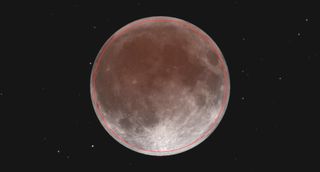
The full moon of September, called the Harvest Moon, will be on Sept. 17 and undergo a partial lunar eclipse visible from anywhere on the night side of Earth.
Full moons occur when the moon is exactly on the opposite side of Earth from the sun – using the moon's celestial longitude (a projection of Earth's longitude lines on the sky) the moon has to be exactly 180 degrees from the sun.
The moon's orbit is slightly tilted relative to the plane of Earth's orbit, by about 5 degrees, so usually the moon is fully illuminated by the sun at that point (if one were standing on the moon it would be local noon).The exact moment of full moon will occur at at 10:34 p.m. EDT (0234 UTC), per the U.S. Naval Observatory.
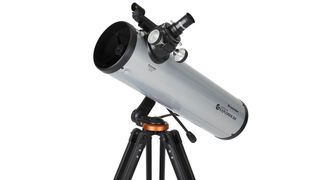
Looking for a telescope for the moon? We recommend the Celestron StarSense Explorer DX 130AZ as the best for basic astronomy in our best beginner's telescope guide.
No matter what night it is, the moon never disappoints through optics of any size. If you want to get a closer look at the moon's many features during lunar eclipses or at any other time, be sure to take a look at our guides to the best telescopes and best binoculars.
And if you want to capture photos of our natural satellite, we have tips for how to photograph the moon, as well as guides to the best cameras for astrophotography and best lenses for astrophotography.
This month, the moon, sun and Earth are lined up so that the full moon will enter part of Earth's shadow, creating a partial lunar eclipse.
Lunar eclipses themselves come in different varieties: a total lunar eclipse is when the moon is completely inside the darkest part of the Earth's shadow, called the umbra. Those are the eclipses where the moon turns a reddish color.
Partial lunar eclipses, like this one, involve the moon getting only partly covered by the umbra, the rest of the moon is in another part of the Earth's shadow called the penumbra. If an observer were standing on the moon's daylight side, they would see Earth partially cover the sun – unless they stood in the part of the lunar surface covered by the umbra. In which case they'd see a total solar eclipse.

Unlike solar eclipses, lunar eclipses are visible from anywhere on the Earth where the moon is visible. In this case one boundary for visibility is in the Pacific on a line roughly from Alaska through Hawaii and French Polynesia. The other runs through Russia, Kazakhstan and western India. At both boundaries the eclipse is visible either close to moonset or moonrise, and the portion where the moon enters the umbra happens before or after the moon is above the horizon.
From the continental U.S., Canada, Mexico, and South America, the entire eclipse is visible, with the timing dependent on the time zone. In New York City, for example, the eclipse starts at 8:41 p.m. EDT, with the penumbral phase. This is when the moon touches the outer part of Earth's shadow; from New York's latitude it will appear to start from the upper left corner.
The penumbral phase is often subtle; observers will say the moon looks slightly more brown or yellowish depending on how clear the sky is and how high up the moon is above the horizon (in New York It will be about 18 degrees high in the east-southeast). The partial phase starts at 10:12 p.m., when the top part of the moon will start to darken as it enters the Earth's umbra. Maximum eclipse is at 10:44 p.m., and from New York it will look as though a chunk of the moon is in shadow. At 11:15 the partial eclipse ends, and the moon enters the penumbral phase again, until 12:47 a.m. Sept; 18, when it fully emerges.

From the West Coast, the initial, penumbral phase is less visible. In Los Angeles, for example, the moon itself rises at 6:55 p.m. PDT. The penumbral phase starts at 5:41 p.m., while the moon is below the horizon. The partial phase at 7:12 p.m. with the moon still low in the eastern sky. Maximum eclipse is at 7:44 p.m. and the partial phase ends at 8:15 p.m. and the penumbral phase at 9:47 p.m.
As one moves north the moon rises later; in Seattle moonrise is at 7:17 p.m. PDT, so the partial phase starts when the moon is closer to the horizon than in Los Angeles – the local time for the other phases of the eclipse is otherwise the same as other cities in the same time zone.
In Alaska, the partial phase isn't visible, because the moon will not have risen yet by the time it ends. In Anchorage local moonrise is not until 8:15 p.m. Alaska Daylight Time, but the partial eclipse is between 6:12 p.m. and 7:15 p.m., so Alaskans will see only the latter penumbral phase (which ends at 8:47 p.m.).
Related: Full moon calendar 2023: When to see the next full moon
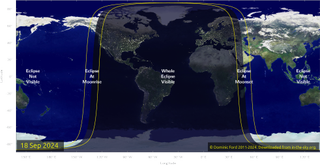
In the Southern Hemisphere the eclipse will appear "upside down." From Sao Paolo, for example, the Earth's umbral shadow will touch the moon from the left (west) and at maximum the bottom left part of the moon will appear dark. The penumbral phase begins at 9:41 p.m. local time, and the umbral (partial) phase at 11:12 p.m. Maximum eclipse is at 11:44 p.m. and the partial eclipse ends at 12:15 a.m. Sept. 18. The eclipse ends at 1:47 a.m.
Towards the eastern side of the Earth's night side, the eclipse will happen after midnight, and the Earth's shadow will appear to approach the moon from the right, the western side. In Paris, the penumbral phase starts at 2:41 a.m. local time, and the partial phase at 4:12 a.m. Maximum eclipse will be at 4:44 a.m. and the partial eclipse ends at 5:15 a.m. The eclipse ends at 6:47, as the moon is getting towards the horizon (it is only 8 degrees high at that point).
Farther east than Paris' time zone the moon sets before the eclipse fully ends; in Istanbul the penumbral phase starts at 3:41 a.m. local time, the partial phase at 4:12 a.m., with maximum eclipse at 4:44 a.m. and the partial eclipse ending at 5:15 a.m. As the partial phase ends the moon is only about 6 degrees high in the west; moonset is at 6:53 a.m., before the end of the penumbral phase at 7:47 a.m.
Visible Planets
Besides the eclipse, on the night of Sept. 17-18 one can spot four of the five naked-eye planets. Venus will be visible just after sunset, though from mid-northern latitudes it will be lower in the sky. From New York, at sunset, which is at 7:00 EDT, according to the U.S. Naval Observatory. the planet will be only 11 degrees above the western horizon. Venus is bright enough that it will start to come out relatively soon after sunset – by the end of civil twilight at 7:28 p.m. the planet will still be six degrees high; just enough that with a clear horizon (for example, if one is looking over a body of water) and near-perfect conditions one can spot it. Venus itself sets at 8:07 p.m. in New York.
Moving south makes it easier to catch the planet. From Galveston, Texas, the sun sets at 7:21 p.m. CDT, and Venus will be about 16 degrees high; by the end of civil twilight at 7:45 p.m. the planet is 11 degrees high, about the span of a fist at arm's length above the horizon, in the west. Venus sets at 8:41 p.m. CDT,
Closer to the equator the planet gets higher; in Singapore, the sun sets at 7:02 p.m. on Sept. 18 (the day the moon is actually full; the time of the full moon is 10:34 a.m. local time) and Venus will be 24 degrees high in the west. By civil twilight, at 7:23 p.m., it is still 19 degrees high; Venus sets at 8:45 p.m.
Once one gets into the Southern Hemisphere, the planet's altitude keeps rising. In Melbourne, Australia, sunset is at 6:13 p.m. Sept. 18, and Venus is 25 degrees above the western horizon. At civil twilight at 6:40 p.m. it is still 20 degrees high; Venus sets at 8:31 p.m. With clear conditions one might be able to see Spica, the brightest star in Virgo, just to the left of Venus as the sky gets dark.
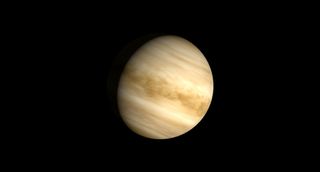
The next planet to rise is Saturn, which rises in New York City at 6:40 p.m. Sept. 17. Sunset is at 7:00 p.m., so Saturn won't be visible until about 7:30 p.m. when the darkening sky will make it visible in the east, about 8 degrees high. Saturn will be visible the entire night; it reaches a maximum altitude of 41 degrees at 11:15 p.m., and sets at 4:49 a.m. Sept. 18. On Sept. 17 Saturn will appear to the right of the moon, making it relatively easy to find.
From Melbourne, Saturn rises at 5:11 p.m. Sept. 18, and will reach an altitude of about 60 degrees when it transits at 11:47 p.m. Saturn there will appear above and to the left of the moon, in the northern sky.
Jupiter rises in New York at 10:58 p.m. EDT Sept. 17; the planet is in the constellation Taurus. Jupiter will be to the left and below Aldebaran, Taurus' brightest star, and to the right of and below Capella, the brightest star in Auriga, the Charioteer, forming a rough triangle in the east as the planet rises. Aldebaran is an orange color and Capella is yellowish, so Jupiter will stand out between them. Another way to know you see a planet is that stars will tend to twinkle, whereas planets – which actually have a disk, even if it is too small to see with the naked eye – do not. For Northern Hemisphere sky watchers Jupiter gets quite high in the sky in the predawn hours; at the latitude of New York it hits 72 degrees when it touches the meridian at 6:24 a.m. Sept. 17.
In the Southern latitudes Jupiter is lower in the northern sky; in Melbourne it rises at 1:02 a.m. on Sept. 18 local time and crosses the meridian at 5:50 a.m. Jupiter will be to the right of Aldebaran. (Capella from Melbourne's latitude is almost too close to the horizon to see at all). Jupiter will reach a maximum of about 30 degrees high.
Last to come up is Mars. In New York Mars rises at 11:08 p.m. EDT on Sept. 17. The planet will reach its highest altitude almost exactly at sunrise on the 18th (6:40 a.m.) and hit an altitude of 73 degrees; the planet will appear to the left of Jupiter as it rises, and below both Jupiter and Mars will be Betelgeuse, one of the shoulders of Orion, the Hunter and also a very strong reddish hue, like Mars.
In Melbourne Mars rises at 2:20 a.m. Sept. 18. As it is the Southern Hemisphere Mars will be to the right of Jupiter, and the star Betelgeuse above them both.
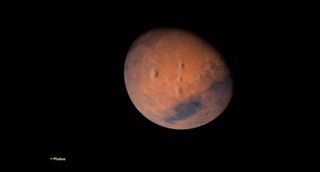
Constellations
The mid-September sky still has the summer stars, but as the night progresses those of fall become more prominent. Early in the evening, one will see the Summer Triangle, made up of Deneb, Altair, and Vega. From the latitude of New York City at about 10 p.m. Deneb, the tail of Cygnus the Swan, will be almost directly overhead, and to the right of it is Vega, the alpha star of Lyra the Lyre. Look towards the horizon and one sees Altair, the alpha star of Aquila the Eagle. Further towards the horizon one can see the teapot shape of Sagittarius, though from much further north than New York or Toronto the constellation starts to inch below the horizon.
If one turns around to face north, one will see the Big Dipper close to the horizon, with the bowl facing up. Use the two stars at the right end of the bowl, called Dubhe and Merak, and make a line upwards to Polaris, the Pole Star. Continue upwards and one ends up between the constellations Cepheus, the King, and Cassiopeia, the Queen; the latter is recognizable by its "W" shape. Below Cassiopeia is Perseus, the Hero. To the right of Cassiopeia is Andromeda, her daughter, marked by four stars that form a rough arc. At the upper end of the arc is the corner of the Great Square, which marks Pegasus, the Winged Horse.
By midnight Taurus will start to rise; and by 2 a.m. the three stars of Orion's Belt will clear the horizon, a harbinger of the winter stars that become visible later in the year.
In the Southern Hemisphere, by about 10 p.m., the Southern Cross is in the southwest, and just above it Hadar, the second-brightest star in Centaurus, the Centaur. Above that is Alpha Centauri, also called Rigil Kentaurus, the sun's closest stellar neighbor. Turning westwards one can see Antares, the heart of Scorpius, which unlike in the Northern Hemisphere appears with the claws (marked by three stars just below Antares) facing downward.
If one looks to the southeast, one can see at about a third to halfway up the sky the star Achernar, which marks the end of Eridanus, the River. By midnight one will see Canopus, the alpha star of Carina the Keel, in the southeast, almost directly below Achernar.
Moon Legends
The September full moon is called the Harvest moon, according to the Old Farmer's Almanac, referring to when corn harvests traditionally started. Sometimes the September moon is further away from the autumn equinox than the October full moon, and in those situations it is called the Corn moon, as happened in 2017. This time, though, the September full moon is closer to the equinox.
Besides being a marker for North American harvests, the full moon of September marks the Jewish holiday of Sukkot, also called the feast of Tabernacles. Observant Jews construct a sukkah, a small structure with a roof of natural material, and spend time inside it. The holiday commemorates the time in the wilderness after the exodus from Egypt described in the Torah. For many Muslims, the third month of the calendar called Rabi'-al-Awwal, is celebrated as the month of Muhammed's birthday, which is marked this year on the 16th of September, just before the full moon.
European settlers adopted some Native imagery for full moon names, but they tend to be those from the Native nations that had the first contacts with the settlers, and they are by no means uniform across the Americas. The Anishinaabe (or Ojibwe) who lived near the Great Lakes, referred to the ninth moon of the year as the Falling Leaves moon. The Cree of Ontario called the September full moon Rutting moon because it was when moose would start scraping the velvet from their antlers ahead of the mating season. In the Pacific Northwest, the Haida called it the Cedar Bark moon (Kíit'aas Kungáay) as they use the bark in weaving.
In China September in the western calendar is in the eighth lunar month called Guìyuè, or Osmanthus Month, for when those flowers bloom. The day of the full moon in the eighth month is called Mid-Autumn Day, and is an important festival in China; there are similar holidays in other east and southeast Asian countries. In Japan, a festival called Tsukimi or "moon viewing" is celebrated the same day, and eating a round dumpling called dango to celebrate the beauty of the moon.
Don't miss our night sky tonight page and monthly skywatching calendar for more celestial events to take in!
Editor's note: If you take an amazing full moon photo you'd like to share for a possible story or image gallery, you can send images and comments to spacephotos@space.com.
Join our Space Forums to keep talking space on the latest missions, night sky and more! And if you have a news tip, correction or comment, let us know at: community@space.com.
Get the Space.com Newsletter
Breaking space news, the latest updates on rocket launches, skywatching events and more!

Jesse Emspak is a freelance journalist who has contributed to several publications, including Space.com, Scientific American, New Scientist, Smithsonian.com and Undark. He focuses on physics and cool technologies but has been known to write about the odder stories of human health and science as it relates to culture. Jesse has a Master of Arts from the University of California, Berkeley School of Journalism, and a Bachelor of Arts from the University of Rochester. Jesse spent years covering finance and cut his teeth at local newspapers, working local politics and police beats. Jesse likes to stay active and holds a fourth degree black belt in Karate, which just means he now knows how much he has to learn and the importance of good teaching.